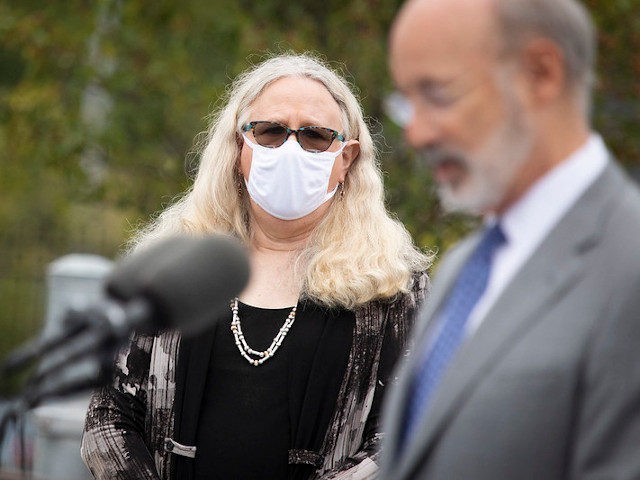The state of Pennsylvania reported nearly 500 deaths from the Wuhan coronavirus in September — its third consecutive month of decline, according to PA Department of Health data.
The state has maintained a public “dashboard” of COVID-19 data, complete with charts of daily cases and deaths. However, those numbers differ slightly from daily reports given in a separate “archives” page — which posts an updated total death count, drawn from the Department’s Vital Records Program as of 11:59 PM on the previous date and broken down by county.
According to the department’s archives, Pennsylvania reported 469 deaths total in September, comparing totaled figures from September 1 and October 1 — an average of 15.63 per day. According to the Department of Health, no date of death is given on these reports, so it is unclear how many occurred in earlier months and how many occurred in September. The CDC cautions that its own count of death certificates can come between one to eight weeks after a death occurs.
September’s total was a 2.89% drop from the 483 deaths reported in August, according to these same archives. August’s total was a 6.75% decrease from the 518 deaths reported in July. July’s total was a more than 50% drop from June’s tally of 1,114.
Twenty counties did not record any new deaths in August. Sixteen of those counties had previously recorded deaths: Carbon, Centre, Clarion, Columbia, Elk, Fulton, Greene, McKean, Montour, Somerset, Tioga, Union, Venango, Warren, Wayne, and Wyoming. Four of those counties have not yet reported any deaths: Cameron, Forest, Potter, and Sullivan.
Twenty-two counties reported three or fewer deaths in July: Adams (3), Bedford (1), Bradford (2), Cambria (2), Clinton (1), Crawford (1), Erie (3), Fayette (1), Huntingdon (1), Indiana (2), Jefferson (2), Juniata (1), Lackawanna (3), Lebanon (3), Luzerne (2), Lycoming (3), Mifflin (1), Perry (1), Pike (1), Schuylkill (2), Susquehanna (1), and Washington (3).
Thirteen counties reported four to ten deaths: Armstrong (9), Blair (7), Butler (7), Clearfield (5), Cumberland (5), Franklin (4), Lawrence (5), Lehigh (10), Mercer (7), Monroe (7), Northampton (4), Snyder (5), and Westmoreland (7).
Four counties reported 11 to 20 deaths: Berks (13), Chester (13), Dauphin (18), and Montgomery (18).
And eight counties reported more than 20 deaths: Allegheny (47), Beaver (27), Bucks (24), Delaware (32), Lancaster (27), Northumberland (28), Philadelphia (64), and York (36). Of these eight, Philadelphia maintains the highest total deaths (1,832), followed by Montgomery (881), Delaware (756), and Bucks (610). No other counties have yet reached 500 total deaths since the state began taking these records in March.
For comparison, the most recent public PA death statistics — from the year 2018 — marks the state’s top causes of death as heart disease (32,713 deaths for the year, an average of 2,726 per month), cancer/malignant neoplasms (27,995 deaths for the year, an average of 2,332 per month), and nontransport accidents (7,207 for the year, an average of 600 per month). [These data were provided by the Pennsylvania Department of Health. The Department specifically disclaims responsibility for any analyses, interpretations, or conclusions.]
These figures reveal a key metric in the ongoing debate over the state’s lockdown measures. As testing became more widely available, confirmed cases began to rise in mid-June but have slowly trended downward since the last week of July. The number of PA hospitalizations bottomed out in mid-July, slowly rose until the end of the month, then dropped quickly — reportedly due to a change in the federal government’s reporting process.
This month, a judge struck down lockdown orders from Governor Tom Wolf and PA Secretary of Health Rachel Levine, ruling that they were unconstitutional. That same week, a PA state senator introduced a bill that would make it a misdemeanor to appear in any public space without a mask.
The coronavirus and its resultant national shutdown came into sharp focus the penultimate month before this year’s presidential election. The state’s Supreme Court ruled in September that polling locations may accept mailed ballots up to three days after the vote on November 3, even without evidence of a proper postmark or a matching signature.
Recent data has not shown a compelling public health justification for vote-by-mail. Wisconsin is one of the only U.S. states that held its primary election with in-person voting after the nation’s coronavirus lockdowns began. Only a few dozen people at maximum were confirmed to have contracted the virus after participating either as voters or poll workers, and none of those cases were fatal. Out of the 413,000 participants, that equals an infection rate below two-hundredths of one percent. Just days later, South Korea held national elections which did not result in any new coronavirus cases.

COMMENTS
Please let us know if you're having issues with commenting.